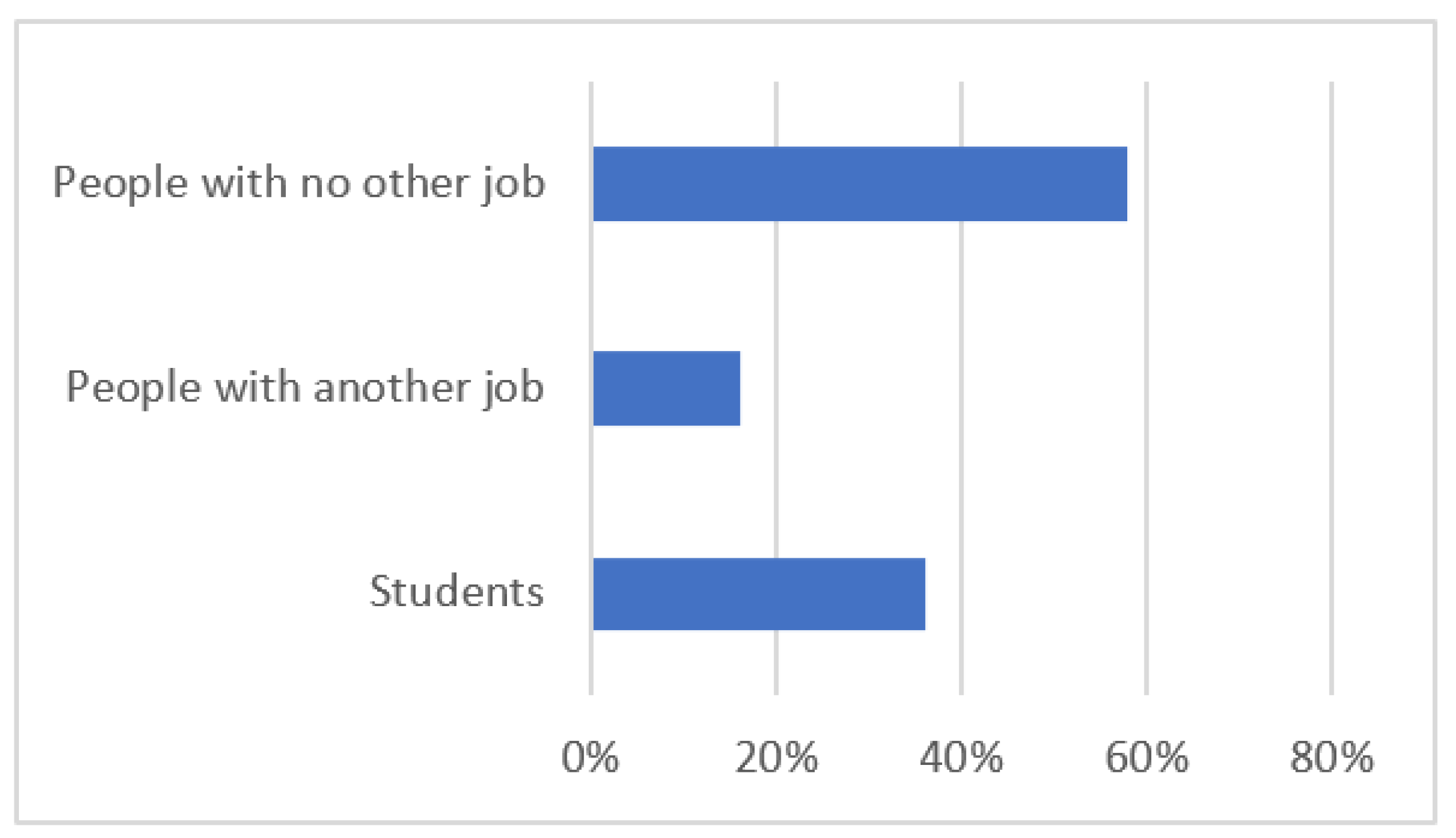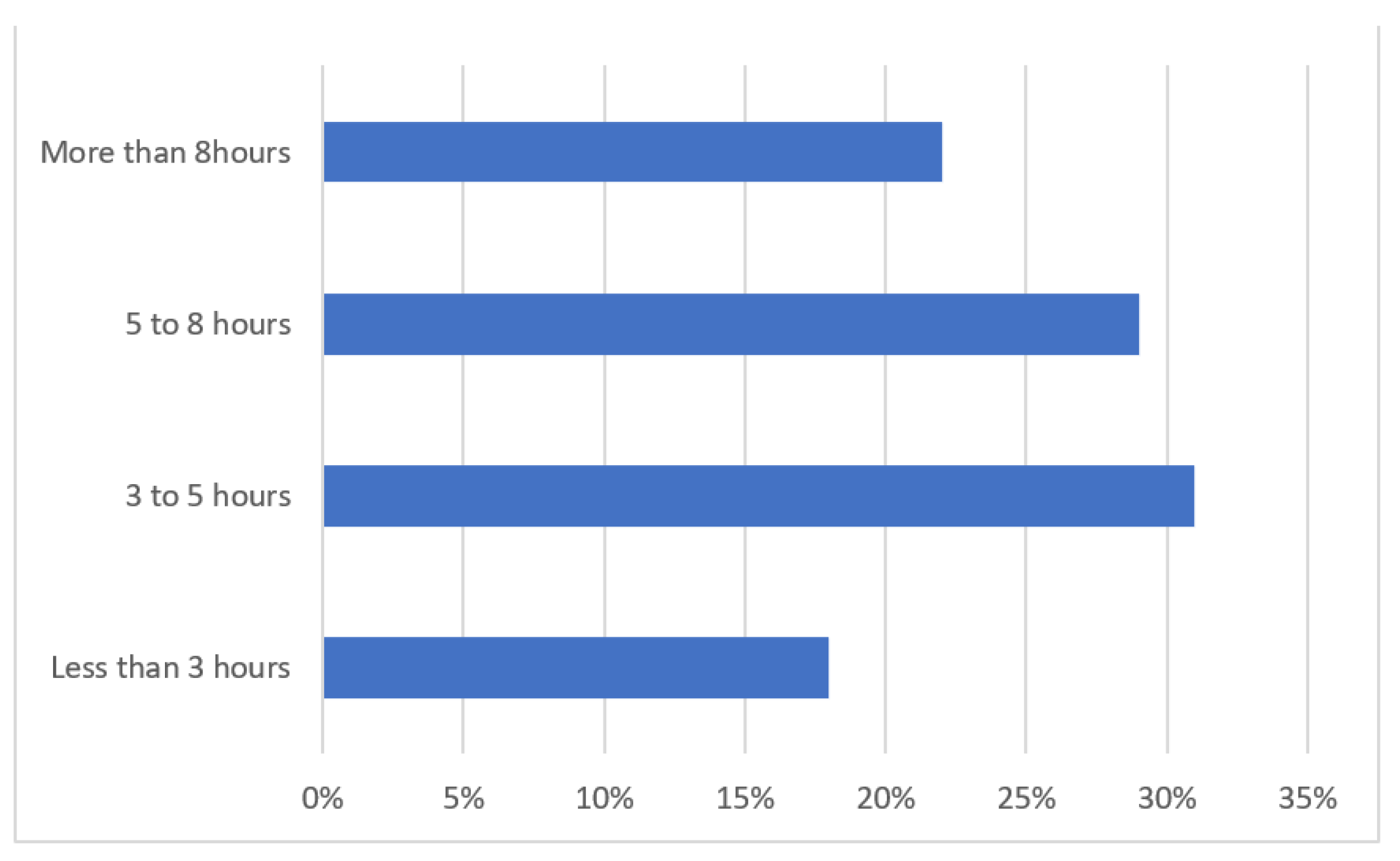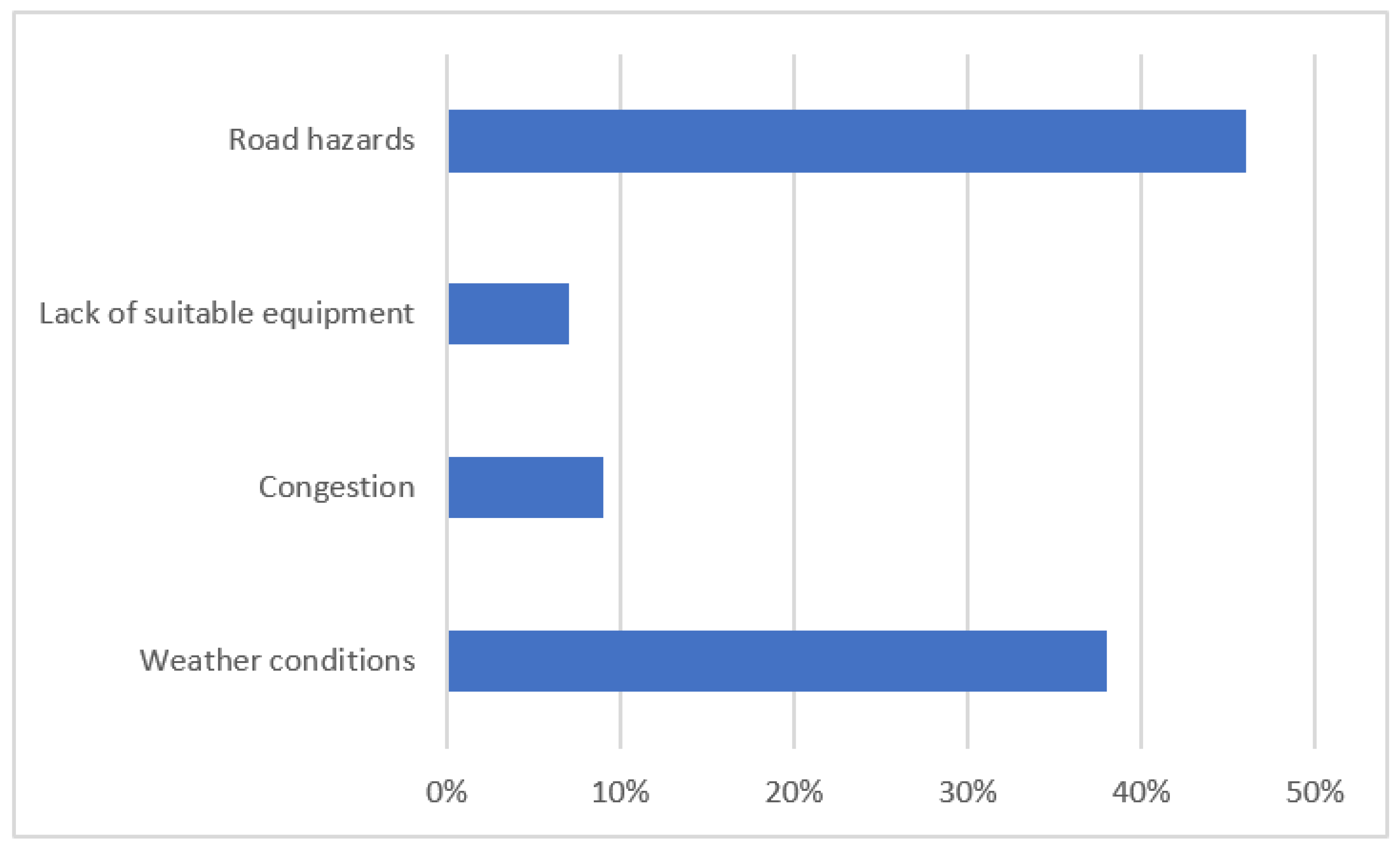Digital Work and Urban Delivery: Profile, Activity and Mobility Practices of On-Demand Food Delivery Couriers in Paris (France)
Abstract
:1. Introduction
2. Literature Review
2.1. Profile of the Couriers
2.2. Characteristics of Platform-Based Delivery Activity
2.3. Mobility Practices of the Couriers
3. Materials and Methods
3.1. Survey
3.2. Questionnaire
4. Profile of the Couriers
5. Characteristics of the Delivery Activity
6. Mobility Practices
6.1. Number of Delivery Runs
6.2. Transport Modes Used
6.3. Risk-Taking and Accidents
7. Conclusions
7.1. Main Contributions
7.2. Policy Challenges
7.3. Limitations and Future Research Directions
Author Contributions
Funding
Informed Consent Statement
Data Availability Statement
Acknowledgments
Conflicts of Interest
References
- Verhoef, P.C.; Broekhuizen, T.; Bart, Y.; Bhattacharya, A.; Dong, J.Q.; Fabian, N.; Haenlein, M. Digital transformation: A multidisciplinary reflection and research agenda. J. Bus. Res. 2021, 122, 889–901. [Google Scholar] [CrossRef]
- Dablanc, L.; Morganti, E.; Arvidsson, N.; Woxenius, J.; Browne, M.; Saidi, N. The Rise of On-Demand ‘Instant Deliveries’ in European Cities. Supply Chain Forum Int. J. 2017, 18, 203–217. [Google Scholar] [CrossRef]
- Dablanc, L.; Savy, M.; Veltz, P.; Culoz, A.; Vincent, M. Des Marchandises Dans la Ville. 2017. Available online: https://hal.archives-ouvertes.fr/hal-01627851/ (accessed on 4 August 2022).
- Klumpp, M.; Ruiner, C. Digitalization and Work Organization in New Urban Food Delivery Systems. Int. J. Food Syst. Dyn. 2018, 9, 399–408. [Google Scholar]
- Lin, J.; Zhou, W.; Du, L. Is on-demand same day package delivery service green? Transp. Res. D Transp. Environ. 2018, 61, 118–139. [Google Scholar] [CrossRef]
- Seghezzi, A.; Winkenbach, M.; Mangiaracina, R. On-demand food delivery: A systematic literature review. Int. J. Logist. Manag. 2021, 32, 1334–1355. [Google Scholar] [CrossRef]
- Chen, S.P. The Democratisation of Meal Delivery Service in France. Master’s Thesis, University of Stavanger, Stavanger, Norway, 2017. [Google Scholar]
- Reis, J.; Amorim, M.; Melão, N.; Cohen, Y.; Rodrigues, M. Digitalization: A literature review and research agenda. In International Joint Conference on Industrial Engineering and Operations Management; Springer: Cham, Switzerland, 2019; pp. 443–456. [Google Scholar]
- Dablanc, L. How on-demand deliveries in cities change services and jobs. In Proceedings of the Presentation at Metrofreight Seminar, Metrans Center, University of Southern California, Los Angeles, CA, USA, 23 July 2018; Available online: https://www.metrans.org/news/how-on-demand-deliveries-in-cities-change-services-and-jobs-new-survey-results (accessed on 28 May 2020).
- Ranieri, L.; Digiesi, S.; Silvestri, B.; Roccotelli, M. A review of last mile logistics innovations in an externalities cost reduction vision. Sustainability 2018, 10, 782. [Google Scholar] [CrossRef]
- Le, T.V.; Stathopoulos, A.; van Woensel, T.; Ukkusuri, S.V. Supply, demand, operations, and management of crowd-shipping services: A review and empirical evidence. Transp. Res. C Emerg. Technol. 2019, 103, 83–103. [Google Scholar] [CrossRef]
- de Stefano, V. Introduction: Crowdsourcing, the gig-economy and the law. Comp. Labor Law Policy J. 2016, 37, 461–470. [Google Scholar]
- Stewart, A.; Stanford, J. Regulating work in the gig economy: What are the options? Econ. Labour Relat. Rev. 2017, 28, 420–437. [Google Scholar] [CrossRef]
- Dieuaide, P.; Azaïs, C. Platforms of work, labour, and employment relationship: The grey zones of a digital governance. Front. Soc. 2020, 5, 2. [Google Scholar] [CrossRef]
- Maginn, P.J.; Burton, P.; Legacy, C. Disruptive Urbanism? Implications of the ‘Sharing Economy’ for Cities, Regions, and Urban Policy; Routledge: London, UK, 2018; Volume 36, pp. 393–398. [Google Scholar]
- Schnieder, M.; Hinde, C.; West, A. Land Consumption of Delivery Robots and Bicycle Couriers for On-Demand Meal Delivery Using GPS Data and Simulations Based on the Time-Area Concept. Sustainability 2021, 13, 11375. [Google Scholar] [CrossRef]
- Ai, N.; Zheng, J.; Chen, X.; Kawamura, K. Neighborhood-Specific Traffic Impact Analysis of Restaurant Meal Delivery Trips: Planning Implications and Case Studies in Chicago. J. Urban Plan. Dev. 2021, 147, 05021013. [Google Scholar] [CrossRef]
- Lord, C.; Bates, O.; Friday, A.; McLeod, F.; Cherrett, T.; Martinez-Sykora, A.; Oakey, A. The sustainability of the gig economy food delivery system (Deliveroo, UberEATS and Just-Eat): Histories and futures of rebound, lock-in and path dependency. Int. J. Sustain. Transp. 2022, 1, 1–13. [Google Scholar] [CrossRef]
- Aguiléra, A.; Dablanc, L.; Rallet, A. L’envers et l’endroit des plateformes de livraison instantanée. Reseaux 2018, 6, 23–49. [Google Scholar] [CrossRef]
- Christie, N.; Ward, H. The health and safety risks for people who drive for work in the gig economy. J. Transp. Health 2019, 13, 115–127. [Google Scholar] [CrossRef]
- Lee, K.; Chae, J.; Kim, J. A courier service with electric bicycles in an Urban Area: The case in Seoul. Sustainability 2019, 11, 1255. [Google Scholar] [CrossRef]
- Qin, H.; Wei, Y.; Zhang, Q.; Ma, L. An observational study on the risk behaviors of electric bicycle riders performing meal delivery at urban intersections in China. Transp. Res. F Traffic Psychol. Behav. 2021, 79, 107–117. [Google Scholar] [CrossRef]
- Ferguson, J.M. Discreet to excrete in the concrete jungle: Women bike messengers and their inventive urban strategies in three US cities. Gender Place C 2017, 24, 85–96. [Google Scholar] [CrossRef]
- Kurt, V.; Piasna, A.; Deahokoupil, J. ‘Algorithm Breaker’ Are not a Different ‘Species’: Attitudes towards Trade Unions of Deliveroo Riders in Belgium (12 June 2019). In ETUI Research Paper Working Paper; ETUI: Brussels, Belgium, 2019; Volume 6, pp. 1–37. [Google Scholar]
- Wu, P.; Zheng, Y. Time is of the Essence: Spatiotemporalities of Food Delivery Platform Work in China; ECIS Research Papers; ECIS: London, UK, 2020; Volume 1, p. 156. [Google Scholar]
- Hall, J.V.; Krueger, A.B. An analysis of the labor market for Uber’s driver-partners in the United States. ILR Rev. 2018, 71, 705–732. [Google Scholar] [CrossRef]
- Drahokoupil, J.; Piasna, A. Work in the Platform Economy: Deliveroo Riders in Belgium and the Smart Arrangement; ETUI Research Paper-Working Paper; ETUI: Brussels, Belgium, 2019. [Google Scholar]
- Aloisi, A. Commoditized workers: Case study research on labor law issues arising from a set of on-demand/gig economy platforms. Comp. Labor Law Policy J. 2015, 37, 653. [Google Scholar]
- Pesole, A.; Brancati, M.C.U.; Macias, E.F.; Biagi, F.; Vazquez, I.G. Platform Workers in Europe: Evidence from the COLLEEM Survey; No. JRC112157; Joint Research Centre: Seville, Spain, 2018. [Google Scholar]
- Barratt, T.; Goods, C.; Veen, A. ‘I’m my own boss…’: Active intermediation and ‘entrepreneurial’worker agency in the Australian gig-economy. Environ. Plan. A Econ. Space 2020, 52, 1643–1661. [Google Scholar] [CrossRef]
- Wibowo, S.; Deng, H.; Duan, S. Understanding Digital Work and its Use in Organizations from a Literature Review. Pac. Asia J. Assoc. Inf. Syst. 2022, 14, 2. [Google Scholar]
- Loffredo, A.; Tufo, M. Digital work in the transport sector: In search of the employer. Work Org. Labour Glob. 2018, 12, 23–37. [Google Scholar]
- Poutanen, S.; Kovalainen, A.; Rouvinen, P. Digital work in the platform economy. In Digital Work and the Platform Economy; Routledge: London, UK, 2019; pp. 3–9. [Google Scholar]
- Galière, S. When food-delivery platform workers consent to algorithmic management: A Foucauldian perspective. New Technol. Work Employ. 2020, 35, 357–370. [Google Scholar] [CrossRef]
- Popan, C. Embodied Precariat and Digital Control in the “Gig Economy”: The Mobile Labor of Food Delivery Workers. J. Urban Technol. 2021, 1, 1–20. [Google Scholar] [CrossRef]
- Wood, A.J.; Graham, M.; Lehdonvirta, V.; Hjorth, I. Good gig, bad gig: Autonomy and algorithmic control in the global gig economy. Work Employ. Soc. 2019, 33, 56–75. [Google Scholar] [CrossRef]
- Constantiou, I.; Marton, A.; Tuunainen, V.K. Four Models of Sharing Economy Platforms. MIS Q. Exec. 2017, 16, 231–251. [Google Scholar]
- de Groen, W.P.; Kilhoffer, Z.; Lenaerts, K.; Mandl, I. Employment and Working Conditions of Selected Types of Platform Work; Digital Commons: Auckland, New Zealand, 2018. [Google Scholar]
- Veen, A.; Barratt, T.; Goods, C. Platform-capital’s ‘App-etite for control: A labour process analysis of food-delivery work in Australia. Work Employ. Soc. 2019, 34, 388–406. [Google Scholar] [CrossRef]
- Vallas, S.P. Platform Capitalism: What is at Stake for Workers? In New Labor Forum; SAGE Publications: Los Angeles, CA, USA, 2018. [Google Scholar]
- Akgüç, M.; Beblavý, M.; Cirule, E.; Kilhoffer, Z. Industrial Relations and Social Dialogue in the Age of Collaborative Economy (IRSDACE); CEPS: Brussels, Belgium, 2018. [Google Scholar]
- Berg, J. Income security in the on-demand economy: Findings and policy lessons from a survey of crowdworkers. Comp. Labor Law Policy J. 2015, 37, 543. [Google Scholar]
- Block, S.; Hennessy, T. “Sharing Economy” or On-Demand Service Economy? Canadian Centre for Policy Alternatives: Ottowa, ON, Canada, 2017. [Google Scholar]
- de Leão, A.A.; dos Cabral, L.S.; Gomes, R.P.; Gonçalves, B.P.; de Oliveira, J.M.L.; de Alencar, D.B. Shared economy: A uber-eats case study in Manaus City. Int. J. Innov. Educ. Res. 2019, 7, 450–466. [Google Scholar] [CrossRef]
- Hasegawa, Y.; Ido, K.; Kawai, S.; Kuroda, S. Who took gig jobs during the COVID-19 recession? Evidence from Uber Eats in Japan. Transp. Res. Interdiscip. Perspect. 2022, 13, 100543. [Google Scholar] [CrossRef]
- Allen, J.; Piecyk, M.; Cherrett, T.; Juhari, M.N.; McLeod, F.; Piotrowska, M.; Bates, O.; Bektas, T.; Cheliotis, K.; Friday, A.; et al. Understanding the transport and CO2 impacts of on-demand meal deliveries: A London case study. Cities 2021, 108, 102973. [Google Scholar] [CrossRef]
- Fuxiang, C.; Wanbao, Y.; Shuzhen, Y.; Haoyuan, Z.; Liping, L.; Limin, O. Analysis on the present situation and influencing factors of road traffic injuries for takeaway riders in Shantou. Inj. Med. 2019, 8, 33–40. [Google Scholar]
- Gregory, K. ‘My Life Is More Valuable than This’: Understanding Risk among On-Demand Food Couriers in Edinburgh. Work Employ. Soc. 2020, 35, 316–331. [Google Scholar] [CrossRef]
- Lachapelle, U.; Carpentier-Laberge, D.; Cloutier, M.S.; Ranger, L. A framework for analyzing collisions, near misses and injuries of commercial cyclists. J. Transp. Geogr. 2021, 90, 102937. [Google Scholar] [CrossRef]
- Egan, R.; Philbin, M. Precarious entitlement to public space & utility cycling in Dublin. Mobilities 2021, 16, 509–523. [Google Scholar]
- Timko, P.; van Melik, R. Being a Deliveroo Rider: Practices of Platform Labor in Nijmegen and Berlin. J. Contemp. Ethnogr. 2021, 50, 497–523. [Google Scholar] [CrossRef]
- Tassinari, A.; Maccarrone, V. Riders on the storm: Workplace solidarity among gig economy couriers in Italy and the UK. Work Employ. Soc. 2020, 34, 35–54. [Google Scholar] [CrossRef]
- Chebance, Z. Les nouveaux Services de Livraison Instantanée à Vélo: Comment Devra S’adapter la Ville Cyclable? (New ‘Instant Delivery’ Services by Bike: How Will Cities Adapt?). Master’s Thesis, Ecole des Mines Paristech and Master TRADD, Paris, France, 2018. [Google Scholar]
- Strale, M. Sustainable urban logistics: What are we talking about? Transp. Res. A Policy Pract. 2019, 130, 745–751. [Google Scholar] [CrossRef]



Publisher’s Note: MDPI stays neutral with regard to jurisdictional claims in published maps and institutional affiliations. |
© 2022 by the authors. Licensee MDPI, Basel, Switzerland. This article is an open access article distributed under the terms and conditions of the Creative Commons Attribution (CC BY) license (https://creativecommons.org/licenses/by/4.0/).
Share and Cite
Aguilera, A.; Dablanc, L.; Rallet, A. Digital Work and Urban Delivery: Profile, Activity and Mobility Practices of On-Demand Food Delivery Couriers in Paris (France). Information 2022, 13, 433. https://doi.org/10.3390/info13090433
Aguilera A, Dablanc L, Rallet A. Digital Work and Urban Delivery: Profile, Activity and Mobility Practices of On-Demand Food Delivery Couriers in Paris (France). Information. 2022; 13(9):433. https://doi.org/10.3390/info13090433
Chicago/Turabian StyleAguilera, Anne, Laetitia Dablanc, and Alain Rallet. 2022. "Digital Work and Urban Delivery: Profile, Activity and Mobility Practices of On-Demand Food Delivery Couriers in Paris (France)" Information 13, no. 9: 433. https://doi.org/10.3390/info13090433
APA StyleAguilera, A., Dablanc, L., & Rallet, A. (2022). Digital Work and Urban Delivery: Profile, Activity and Mobility Practices of On-Demand Food Delivery Couriers in Paris (France). Information, 13(9), 433. https://doi.org/10.3390/info13090433






